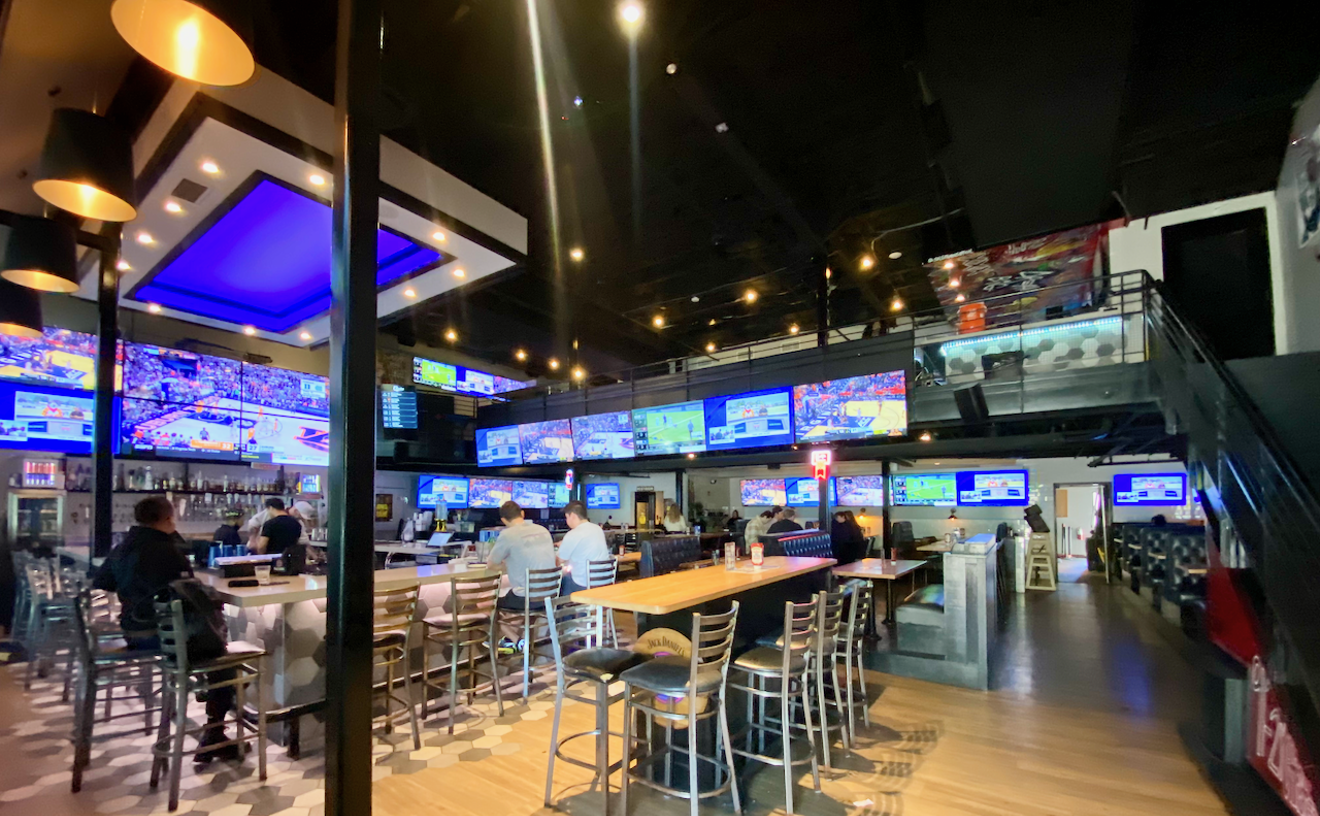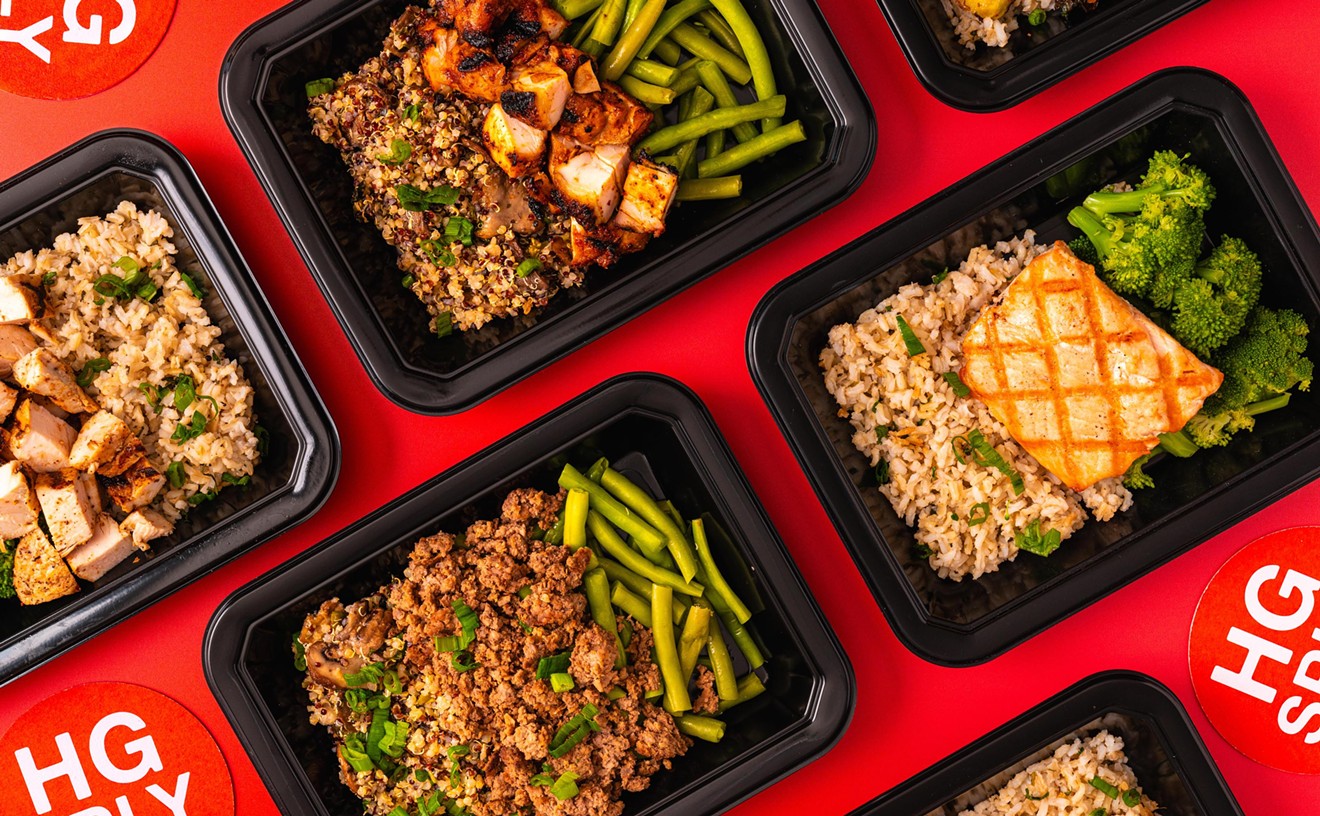Gui rests on history. This cubed structure on McKinney Avenue has slowly morphed, traversing cultures with global hybrids—some eventually dumbed down for your pleasure—simmering within. In mid-1990s it was Yellow, Avner Samuel's I'm-here-again-gone-again-back-again eclectic global ingredient collage. Here you could savor beef sashimi (pre-wagyu) with pickled ginger and hijiki seaweed, or corn chowder Southwesternized with fried scallion and chilies. Renee Peeter's Watel's (now in a cottage on Allen Street) followed, a French organ grinder with kidneys and brains and sweet breads (in chive butter) for those precious few bored with cassoulet.
Chef Joseph Gutierriz painted the building a regrettable orange and called it Tutto, a Spanish-Italian hybrid. Bone-in lamb on a bed of grapes marinated in Sambuca. Pheasant marinated in vermouth. And so on. Gutierriz sold it, and after a brief Gutierriz-free stint, Temptations emerged from the chrysalis, a less-than-satisfying Indian restaurant.
Enter Gui. Gui (goo-eee), which means grill in Korean, is billed as a Korean Japanese bistro. But it is more Japanese than Korean; more bar than bistro. You won't find riveting Korean authenticity. There is no congestion of Korean side dishes arching around your place setting—the pickled fish and crab, cold soup, the pickled radishes or cucumber or turnips, spiced fried bean curd or stuffed eggplant. You won't find traditional Korean barbecue (bulgogi) either, with thin strips of beef, chicken or squid, marinated and seared on gas-fired grills at your table, such as you'll find in Korea Town near Royal Lane and Interstate 35. There is no kimchi on the menu.
This is a near fatal mistake. "Korean food is too spicy, too flavorful for American people," says owner Kevin Cha. Perhaps, but when you ponder Peeter's brains, Cha's claim is a little hard to swallow. Cha has operated restaurants in Los Angeles and Michigan. After he left those restaurants and those places, he says he traversed the country, eating, drinking and sleeping for two weeks straight—a crash course of culinary hedonism. Then, he chose to exploit his accumulated learning in Dallas.
Oddly, while kimchi does not appear on the menu, it can be had by special request. It's house-made, meticulously cleaved cabbage fermented in brine, garlic, scallions and chili peppers and cut into beautifully symmetrical strips, draped over one another on a tiny plate like creased, folded laundry. Flaccid. Crisp. Briny bleed leaching from the edges. Gui kimchi is more mild than fiery, adapted no doubt to Cha's perception of McKinney Avenue palates. To surge it with more savor, Cha adds anchovy to the brine, which more than compensates for the chili paucity.
The Japanese facet of this bistro has more vigor and more menu real estate. There are the requisite edamame and tempura and teriyaki. There is a competent sushi selection: firm, well-textured uni, rich as custard—satiny tongues of tuna and hamachi; strips of semi-translucent squid, breathy mint heaving through the slitted flesh. It's cool instead of warm. The rice isn't brittle.
Gui is keenly aware of its audience—the aspirational, on-demand consumer more in tune with lifestyle-transformation-via-gadget than the movement of spice and influence of herb in the culinary canon. Thus we get "baby fat," a deep-fried and sectioned squid body stuffed with a tartare-like paste of marinated and ground tuna whipped with mayo and Korean chili paste. We also get chixtix (yakatori) and electrica avocado (eel, avocado on greens with eel sauce), which kind of sounds like a pole dancer sponsored by Greenpeace. Very hip hybrid.
Gui takes panko bread crumb-coated and fried soft-shell crab and nestles it into a sheaf of greens. Gui calls it "spider on a leaf." It looks like a tarantula, its legs folded inward like the predator at rest, sprung to pounce if need be, those panko crumbs fried into perfect mimicry of a spider pelt. This might be the best example of the fried soft-shell crab—Japanese restaurant cliché it has become—we've ever tasted. It's crisp but tender. The teeth break through the exoskeleton and are confronted with none of the watery mush of liquefied viscera oftentimes generated from some weird combination of freezing and deep frying.
Gui describes itself as attractive, hip, sleekly designed. Thus, it voices the musical throbs, techno pulses and microchip swishes that seem to work voodoo on the contemporary, on-demand libido. Cha says this sonic cuddle makes the young feel nurtured and the old feel young—maybe because it sounds suspiciously like a college hangover. Servers wear black T-shirts with a glittered "Gui" and a glittered cross on the fabric, the latter owing to Cha's Christian embrace.
The room is stark and dark, black tables with lanterns, a lit partition separating dining room from sushi bar that casts glow into strings of crystal beads dangling from the ceiling. The sushi bar is surfaced in black marble, its backdrop yellow tiles with red flower stickers applied to the surface. But perhaps the oddest decorative piece is the tree in front of the restaurant, a steel sculpture thick with white LED lights, an electrified metal and microchip display of cherry blossoms.
In spite of the prevalence of Gui faux, there is much to love. Pa jun, the classic Korean pancake, is a thick, chewy pie (ground rice is added to the flour) with crispy edges and shrimp, calamari and scallion as embeds. It arrives on a sizzling metal plate—aromatic, filling, tasty.
"Game over" is a heap of meticulously sliced bone-in beef short rib, marinated in a barbecue sauce packed with zesty savor. These ribs are deliciously rich, prodding into existence new addictions as you chew the last bit of richness from the thin bone shards. There is teriyaki salmon steak, a strip of fish covered with a froth of fried potato and draped over a concave bun of sushi rice. Fish was slightly mushy.
If you come here, dine at the sushi bar. Prattle with the chefs. They'll tease you with things they dare not put on the menu for fear of spooking the Uptown natives. We sampled a plate of baked white tuna topped with tobiko and tenuous threads of red onion, in a warm, slightly sweet soy mustard broth. Soothing and buttery, the fish thaws over the tongue in a watery savor.
Despite its earnest mainstreaming, Gui holds its own. Our wish would be that it muscle up the Korean aspect. There's an underestimation here, and Dallas very well could be ahead of Cha's curve. Done right, Gui could go a long way toward evangelizing the young and the timid and the young-feeling old to Korean culinary writ.
2719 McKinney Ave., 214-720-9229. Open 11:30 a.m.-2:30 p.m. Monday-Friday; 5-10 p.m. Sunday-Thursday; 5 p.m. -midnight Friday & Saturday. $$$










